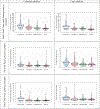Parkinson's Disease Cognitive Phenotypes Show Unique Clock Drawing Features when Measured with Digital Technology
- PMID: 33682726
- PMCID: PMC8108094
- DOI: 10.3233/JPD-202399
Parkinson's Disease Cognitive Phenotypes Show Unique Clock Drawing Features when Measured with Digital Technology
Abstract
Background: A companion paper (Crowley et al., 2020) reports on the neuroimaging and neuropsychological profiles of statistically determined idiopathic non-dementia Parkinson's disease (PD).
Objective: The current investigation sought to further examine subtle behavioral clock drawing differences within the same PD cohort by comparing 1) PD to non-PD peers on digitally acquired clock drawing latency and graphomotor metrics, and 2) PD memory, executive, and cognitively well phenotypes on the same variables.
Methods: 230 matched participants (115 PD, 115 non-PD) completed neuropsychological tests and dCDT. Statistically-derived PD cognitive phenotypes characterized PD participants as PD low executive (PDExe; n = 25), PD low memory (PDMem; n = 34), PD cognitively well (PDWell; n = 56). Using a Bayesian framework and based on apriori hypotheses, we compared groups on: total completion time (TCT), pre-first hand latency (PFHL), post-clock face latency (PCFL), total clock face area (TCFA), and total number of pen strokes.
Results: Fewer strokes and slower performance to command were associated with higher odds of PD diagnosis, while a larger clock face in the copy condition was associated with lower odds of PD diagnosis. Within PD cognitive phenotypes, slower performance (TCT, PCFL) and smaller clock face to command were associated with higher odds of being PDExe than PDWell, whereas larger clock faces associated with higher odds of being PDMem than PDWell. Longer disease duration, more pen strokes (command) and smaller clocks (command) associated with higher odds of being PDExe than PDWell.
Conclusion: Digitally-acquired clock drawing profiles differ between PD and non-PD peers, and distinguish PD cognitive phenotypes.
Keywords: Parkinson’s disease; bayesian analysis; executive function; memory; propensity score analysis.
Figures



Similar articles
-
Cognitive Correlates of Digital Clock Drawing Metrics in Older Adults with and without Mild Cognitive Impairment.J Alzheimers Dis. 2020;75(1):73-83. doi: 10.3233/JAD-191089. J Alzheimers Dis. 2020. PMID: 32250300 Free PMC article.
-
Classifying Non-Dementia and Alzheimer's Disease/Vascular Dementia Patients Using Kinematic, Time-Based, and Visuospatial Parameters: The Digital Clock Drawing Test.J Alzheimers Dis. 2021;82(1):47-57. doi: 10.3233/JAD-201129. J Alzheimers Dis. 2021. PMID: 34219737 Free PMC article.
-
Normative References for Graphomotor and Latency Digital Clock Drawing Metrics for Adults Age 55 and Older: Operationalizing the Production of a Normal Appearing Clock.J Alzheimers Dis. 2021;82(1):59-70. doi: 10.3233/JAD-201249. J Alzheimers Dis. 2021. PMID: 34219739 Free PMC article.
-
Which Test Is the Best to Assess Visuo-Cognitive Impairment in Patients with Parkinson's Disease with Mild Cognitive Impairment and Dementia? A Systematic Review and Meta-Analysis.J Parkinsons Dis. 2022;12(6):1749-1782. doi: 10.3233/JPD-223238. J Parkinsons Dis. 2022. PMID: 35599499
-
Meta-Analysis of Cognition in Parkinson's Disease Mild Cognitive Impairment and Dementia Progression.Neuropsychol Rev. 2022 Mar;32(1):149-160. doi: 10.1007/s11065-021-09502-7. Epub 2021 Apr 16. Neuropsychol Rev. 2022. PMID: 33860906 Review.
Cited by
-
The New Frontier of Perioperative Cognitive Medicine for Alzheimer's Disease and Related Dementias.Neurotherapeutics. 2022 Jan;19(1):132-142. doi: 10.1007/s13311-021-01180-w. Epub 2022 Jan 27. Neurotherapeutics. 2022. PMID: 35084722 Free PMC article. Review.
-
A Network Analysis of Digital Clock Drawing for Command and Copy Conditions.Assessment. 2025 Jan;32(1):119-129. doi: 10.1177/10731911241236336. Epub 2024 Mar 18. Assessment. 2025. PMID: 38494894 Free PMC article.
-
Overview of the Complex Figure Test and Its Clinical Application in Neuropsychiatric Disorders, Including Copying and Recall.Front Neurol. 2021 Aug 31;12:680474. doi: 10.3389/fneur.2021.680474. eCollection 2021. Front Neurol. 2021. PMID: 34531812 Free PMC article. Review.
-
The functional connectivity and neuropsychology underlying mental planning operations: data from the digital clock drawing test.Front Aging Neurosci. 2022 Sep 20;14:868500. doi: 10.3389/fnagi.2022.868500. eCollection 2022. Front Aging Neurosci. 2022. PMID: 36204547 Free PMC article.
-
Contributions of Cardiovascular Burden, Peripheral Inflammation, and Brain Integrity on Digital Clock Drawing Performance in Non-Demented Older Adults.J Alzheimers Dis. 2023;95(2):453-467. doi: 10.3233/JAD-221011. J Alzheimers Dis. 2023. PMID: 37545230 Free PMC article.
References
-
- Dubois B, Burn D, Goetz C, Aarsland D, Brown RG, Broe GA, Dickson D, Duyckaerts C, Cummings J, Gauthier S, Korczyn A, Lees A, Levy R, Litvan I, Mizuno Y, McKeith IG, Olanow CW, Poewe W, Sampaio C, Tolosa E, Emre M (2007) Diagnostic procedures for Parkinson’s disease dementia: recommendations from the movement disorder society task force. Movement Disorders 22, 2314–2324. - PubMed
-
- Cosentino S, Jefferson A, Chute DL, Kaplan E, Libon DJ (2004) Clock Drawing Errors in Dementia, Neuropsychological and Neuroanatomical Considerations. Cognitive Behavioral Neurology 17, 74–84. - PubMed
-
- Ogden JA, Growdon JH, Corkin S (1990) Deficits on visuospatial tests involving forward planning in high-functioning Parkinsonians. Neuropsychiatry, Neuropsychology, & Behavioral Neurology 3, 125–139.
-
- Grossman M, Carvell S, Peltzer L, Stern MB, Gollomp S, Hurting HI (1993) Visual Construction Impairments in Parkinson’s Disease. Neuropsychology 7, 536–547.
Publication types
MeSH terms
Grants and funding
LinkOut - more resources
Full Text Sources
Other Literature Sources
Medical

